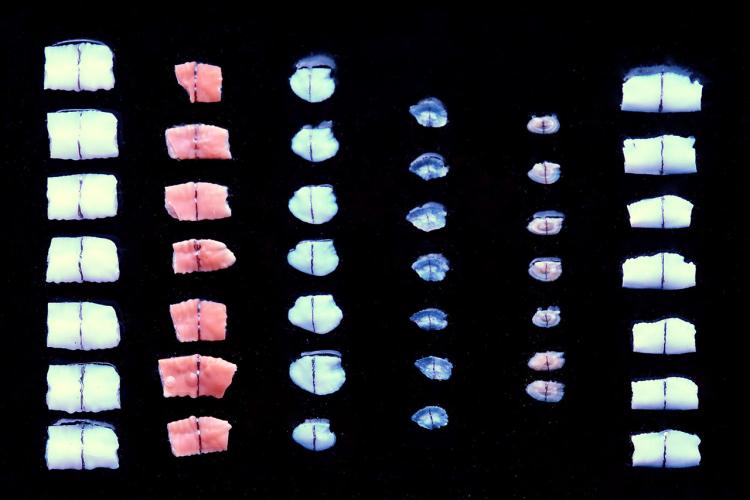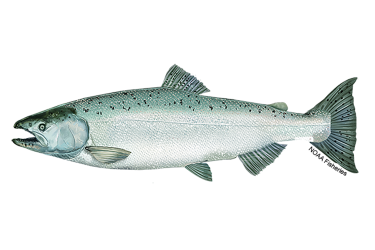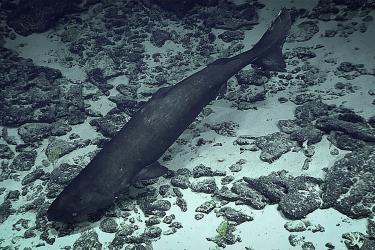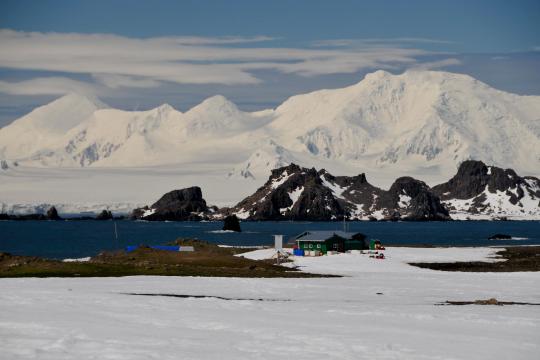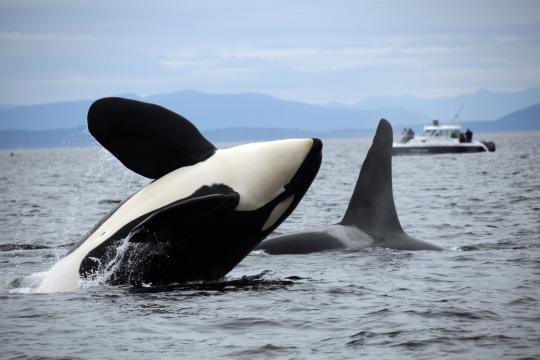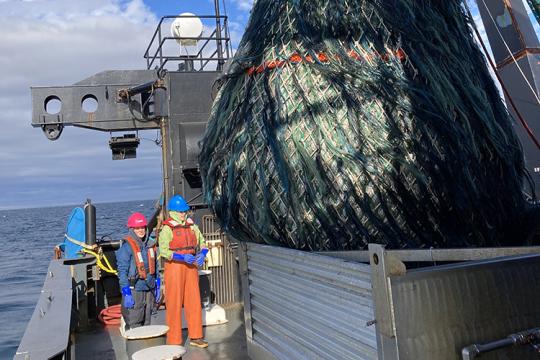Overview
NOAA Fisheries scientists study different aspects of a fish's life and development, including growth, maturity, and natural mortality. Scientists specifically assess the age and growth rates of fish species by studying fish ear stones, called otoliths. Otoliths reveal the ages of individual fish, almost like counting the rings in a tree. Knowing the age distribution of a fish population helps to better monitor, assess, and manage stocks for long-term benefits.
Scientists and fisheries managers can use these data to help understand how fish populations react to commercial and recreational fishing and environmental stressors, such as predation, pollution, and climate change.
Science and Technology
Why Age Fish?
Data on fish size, combined with age information, provide growth rates. The number of fish in a cohort (population of fish born in a given year) decreases from year to year. When fish age is known, this information gives a measure of mortality rate due to both fishing and natural causes. Knowing how old a fish is when it becomes mature is also important. Any of these values may change over time, so it is important to determine the age of fish samples regularly.
It is impractical to catch all the fish in a population. A better option is to catch a small part of the population and determine the relative numbers of fish at each age. Stock assessments use the age data, in addition to other data, to build mathematical models of the entire population. The most complex models need a higher number of ages. These models estimate the total number of fish in a wild stock and predict the effects of fishing.
Ear Stones
The otolith (ear stone or ear bone) is the most commonly used structure for determining the age of fish. Otoliths are calcium carbonate structures found inside the heads of bony fish; sharks and rays lack otoliths. Each fish has three pairs of otoliths, which vary in shape and size. Otoliths are part of the fish's inner ear, allowing fish to hear and sense vibrations in the water and providing a sense of balance so they may better navigate their surroundings.
Otoliths grow throughout a fish's life by accumulating material on the outer surface around a core. The accreted material is composed of alternating layers, which are referred to as being either opaque or translucent based on their optical properties. When a fish is feeding actively (often in summer), calcium from the fish's diet accretes a wide opaque layer on all surfaces of the otolith. When the fish is eating less, the otoliths grow more slowly and gain a narrower translucent layer. The two layers, the translucent and opaque, together represent one year of growth, called an annulus. Otolith growth and development may be affected by temperature or other external conditions for many species.
Scales and Other Structures
For some species, scales may be used to determine age. Scales have concentric ridges, which form closer together during the winter. Scales are seldom used for ageing groundfish because the annuli tend to crowd together near the edge, which leads to underestimated ages. Scales also erode on the edges, shed, and regenerate. The erosion can lead to falsely low age readings and inaccurate data.
Other structures that form annuli are fin rays, bones, and vertebrae. Vertebrae are often used for sharks and skates, which do not have otoliths. These methods should be evaluated on a species-by-species basis, as the structure used for each species depends on which is the most accurate and easy to use.
How are Fish Aged?
Seasonal changes in growth of individual fish are recorded in various hard structures, such as otoliths, within the fish. In otoliths, for example, the seasonal changes appear as alternating opaque and translucent rings. You can count the number of paired opaque and translucent rings, or annuli, to estimate the age of a fish, so a fish with two annuli would be two years old (see image below). The annuli are visible when magnified under a microscope at 6 to 40 times life-size. It is often necessary to slice the otolith across the core to see all the annuli. Scientists typically count annuli from the core to the edge of the otolith to obtain an age estimate.
Most fish age determination laboratories around the world have agreed to assign a birth date of January 1st to fish regardless of the actual spawning date. This convention allows scientists to estimate birth year and assign each fish to the correct cohort, which is essential for effective stock assessment.
Age and growth vary across fish species and geographical areas, so each science center and its scientists work with select species and use the appropriate methods for ageing each one.
Consistency of Age Data
A final aspect of age determinations is the need to maintain consistency from year to year. Stock assessment scientists also need to know the degree of ageing error to include in their mathematical population models.
Age determination staff test themselves regularly to ensure that their age data are both accurate and precise. Accuracy testing means reviewing samples from known-age reference collections to test whether an estimated age matches the true age of a fish. Precision testing means that a portion of the samples is reviewed, either by the same person or a second person, to measure the repeatability of age estimates. In both cases, the test ages should generally match the prior ages. Samples are also exchanged periodically between laboratories to ensure consistency between labs.
Regional Activities
Alaska
More than 30,000 otoliths are read annually by NOAA Fisheries Alaska Fisheries Science Center scientists.So far, the Science Center has collected more than 1.1 million fish otoliths for ageing. The Center's otolith collection database is a real-time inventory of survey and observer otolith collections.
Otoliths are collected primarily from NOAA Fisheries surveys and fisheries observers. The Center's Age and Growth Programs reads otoliths for groundfish species collected in the Bering Sea, Aleutian Islands, and the Gulf of Alaska. Current species studied include walleye pollock, sablefish, Pacific cod, Atka mackerel, yellowfin sole, Pacific ocean perch, and various other flatfish and rockfish species. View a summary of aged groundfish species.
Learn more about age and growth research in Alaska
Northeast
Each year, scientists at the Northeast Fisheries Science Center determine the ages of about 60,000 fish and shellfish from samples of over 20 species, including Atlantic cod, haddock, yellowtail flounder, summer flounder, and many more. Samples are collected on NOAA surveys and commercial fishing boats between the Gulf of Maine and Cape Hatteras, North Carolina in the northwest Atlantic Ocean. View a list of the species collected for age and growth studies in the Northeast.
Learn more about age and growth and fishery biology in the Northeast
Pacific Islands
The Pacific Islands Fisheries Science Center conducts age-based demographic research on coral reef fish, deepwater snappers and groupers, and pelagic fish from across the Pacific Ocean. The research areas include three archipelagos (Hawaiian, Mariana, and Samoan) and the North Pacific pelagic environment. Otoliths are collected on research cruises, through biosampling and observer programs, and directly from fishermen. We specifically examine how life history traits vary across a species’ range due to anthropogenic effects or environmental factors.
Learn more about age and growth and fishery biology in the Pacific Islands
Southeast
The Southeast Fisheries Science Center laboratory conducts ageing studies on species managed largely from federal waters within the Gulf of Mexico, such as several reef fish (snappers and groupers) and certain coastal pelagic species (mackerels). Some highly migratory species have been aged to contribute to the International Commission for the Conservation of Atlantic Tunas population assessments.
Learn more about fisheries biology and age and growth in the Southeast
West Coast
The Northwest Fisheries Science Center laboratory conducts ageing studies on approximately 20-30,000 fish each year by examining hard calcified structures, like fish otoliths, spines, vertebrae, and fin rays, using various validated scientific methods. Our Cooperative Ageing Project is the primary source of new age data for Pacific coast groundfish. We determine the ages of many rockfish species, such as canary, darkblotched, and Pacific ocean perch; flatfish, such as dover sole, petrale sole, and arrowtooth flounder; big skate, sablefish, Pacific whiting (or hake), lingcod and spiny dogfish.
Learn more about ageing groundfish on the West Coast
International Collaboration
In the northwest Atlantic Ocean, NOAA Fisheries samples fish on the Canadian side of Georges Bank and the Gulf of Maine. Both the United States and Canada work together to form the Transboundary Resource Assessment Committee, which uses age data in population assessments for species including:
- Atlantic cod
- Haddock
- Yellowtail flounder
- Atlantic mackerel
- Atlantic herring
These species of fish are found on both sides of the border. NOAA Fisheries staff age Canadian samples of yellowtail flounder and Atlantic herring. International ageing exchanges are also conducted to make sure both countries use consistent methods.
The Committee of Age Reading Experts (CARE) is a cooperative effort between international, state, and federal agencies. It is dedicated to standardizing and improving age determination techniques and activities for Pacific Ocean fish species. CARE members include the Department of Fisheries and Oceans Canada, the International Pacific Halibut Commission, NOAA Fisheries, U.S. state agencies, and other marine organizations.
